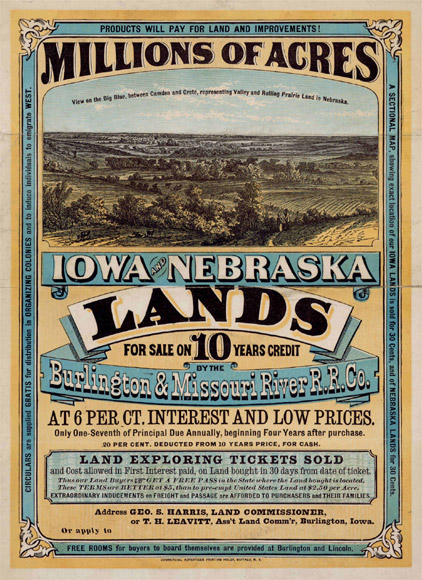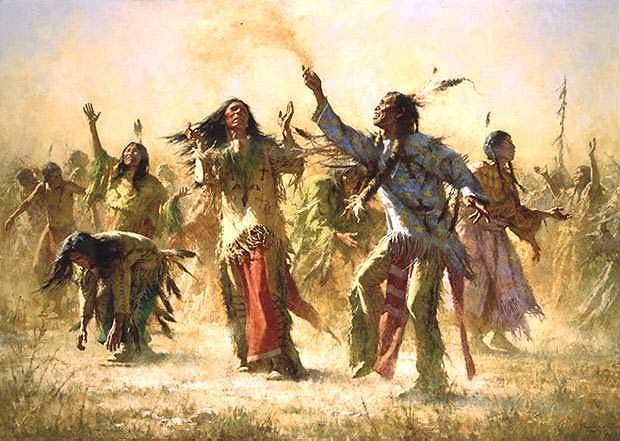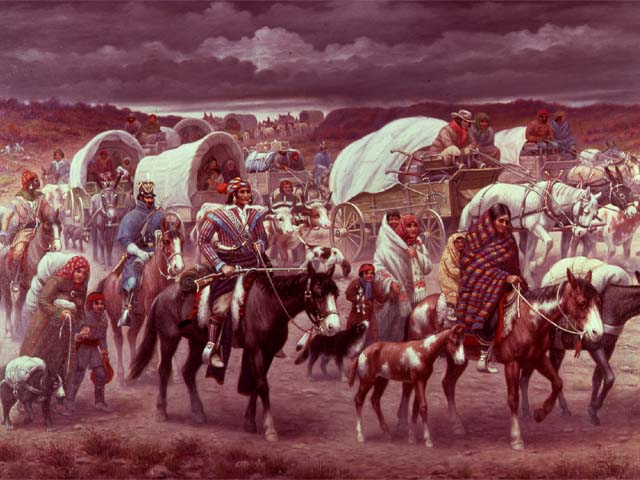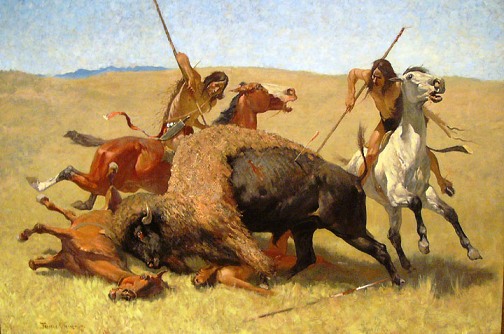The idea of American Manifest Destiny is not exclusive to the mid-eighteenth century, though the period of imperial “Westward Ho!” is one of the more conspicuous symptoms of that deeper, existential malady—the messianic mission to make the world over in America’s image. The concept, for its adherents, has been somewhat of a mixed blessing. Not only does this mandate hearken back to the founding of the Republic but, to this very hour, it gallops apace under the banner of global democracy. The crusade to extend salvation across the globe—to make all places not America, America; a normative democracy based on property rights;—is matched only by a more recent, penitent reflex to make all places America, un-American.
In the light of the volumes on happiness written by the Marquis de Chastellux, it was not surprising that Chastellux should think the discovery of America a blessing. Civilization, he insisted, is the product of commerce, and the discovery of the New World had immensely stimulated commerce. It was part of an early articulation of the concept of America having a manifest destiny; the role of chosen nation. A phenomenon that was intangible, ambiguous and not be tied to a date, event or even a specific period of time.

''During the segment, the term "Manifest Destiny" was used. So on this week's segment The Homeboy Mad wanted to get a li'l deeper on the phrase and common belief of the United States having the divine right to expand the 13 colonies to the pacific ocean in the blood of our ancestors.''
”Manifest Destiny existed and still exists as the philosophy that embraces American history as a whole. Manifest Destiny is an intangible ideology that created American history. In its simplest form, Manifest Destiny can be defined as, “A Movement.” More specifically, it would be the systematic body of concepts and beliefs that powered American life and American culture.’
”Here is my favorite passage from Chastellux’s Essay:
Anatomy hath lifted up the veil of humanity; it hath discovered an innumerable quantity of machines, which give motion to these frivolous decorations of life, and proved to us that Moses made use of extremely bold hyperbole, when he asserted that God created man after his own image. This science, at once terrible and useful, hath taught those destructive weapons, which were accustomed to deprive us of our being, the new art of preserving it, and tracing out for them, even in our very entrails, a dark, but certin road, hath enabled the artist to remedy those disorders which he could not see.

''The phrase was initially the product of a political agenda to acquire territories and expand the United States westward. This was not the first use of American propaganda and certainly not the last. The proposed movement would influence everyone from the farmer to the politician, because it would provide new land for those who were willing to make the journey and effort to claim it. ',
That is, when we get over Moses’ flattering lie and realize that we are meat-machines, we can transform the knife to the scalpel and actually improve human life. Chastellux plumped for a science of politics that would increase human happiness, by which he clearly meant: consumption per capita. ( Will Wilkinson )
What a cornucopia of blessings came from the activities Chastellux so ebulliantly described. Commerce brought new wealth and distributed wealth anew, thus leveling ancient inequalities. It introduced luxuries, and luxuries were a mark of high civilization. It expanded horizons, intellectual as well as geographical. Even trade in slaves was not wholly to be bad, for according to Chastellux it ameliorated their lot, and who could doubt, that, in time, the Americans would put an end to this pernicious institution.

Hope Springs eternal. Howard Terpning.As a result, the Ghost Dance religion swept the Great Plains like wildfire. The Indians' culture had been destroyed by the white man and the Indians were ready to grasp at any straw that would promise a return to the old ways. By 1890, most tribes were practicing the religion, which prophesied that all the buffalo would reappear, the white man would vanish and all the Indian dead would come back to life. It was said that the Ghost Dance shirts and dresses would protect the wearer from white men's bullets, but at the Wounded Knee massacre, the Indians discovered that the garment
ve no protection. After that tragedy, their last hope was destroyed and they lost heart.John Graves Simcoe had other views; namely that these eloges were part of nothing more than the beginning of the Amwerican legacy and the gift for endless hyperbole and hucksterism to promote American materialism and individuality. ”In it Simcoe takes issue with the many statements and observations on the Revolutionary War made by the Marquis de Chastellux, which were published in English translation in 1787, in which the Marquis condemns the British incompetence, their wanton destruction of property, villainous crimes against the Americans, and use of the Indians in the war. From his own first hand knowledge, Simcoe refutes each and every charge made by the Marquis, defends the integrity of the British Army, condemns the atrocities of the Rebels, and points out the treachery and manipulations of the Rebel leaders inflicted on their own brothers, the Loyalists. George Washington, Benjamin Franklin and the Marquis de Lafayette particularly, come under severe criticism from Simcoe. ”
There was quite a difference between the gay and worldly Chastellux and the volatile Condorcet whom contemporaries described as a volcano covered with snow. Of all those who participated in Abbe Raynal’s prize contest on whether America was a mistake, the marquis de Concordet was easily the most distinguished, the one who made the strongest impression on his own time, and the one whose fame and fate still affects most deeply.
”His L’Esquisse d’un tableau historique des progrès de l’esprit humain (1795; Sketch for a Historical Picture of the Progress of the Human Mind) gives full expression to the ideals of the French Enlightenment, imagining the potential of reason farther into the future than had any of his predecessors. It is also the last expression of Enlightenment optimism, written as the “Reign of Terror” following the French Revolution was just beginning. His support for the rights of women and slaves was unique in his time, and he joined with other French philosophers in celebrating the progress towards liberty he saw in Revolution-era America.”

''In an 1860s Masonic print, U.S. Founding Father and Freemason George Washington is surrounded by portraits of Masons Andrew Jackson and the Marquis de Lafayette, as well as biblical scenes and Freemason symbols. Washington wears the ritual Masonic apron, modeled on those of stonemasons. To Freemasons, the apron symbolizes innocence and sacrifice. The trowel in his right hand, another traditional masonry tool, symbolizes the spreading of brotherly love. ''
He was a mathematician and perpetual Secretary to the Academy of Sciences; he was an economist, a disciple of Turgot, whose biography he subsequently wrote, and of that other quasi-physiocrat, Adam Smith, and his wife had translated the ”Theory of Moral Sentiments” into French. He was the only true philosopher who was permitted to play a significant role in the French Revolution, whose coming he had foreseen. He formulated programs for public education, which was never alas, adopted and he helped frame the ill-starred constitution of 1793. He was not merely a precursor of the Revolution but, in the end, a victim.

''The Plains Indian tribes brought their own medicinal traditions. Medicine men remove foreign objects "shot" into a patient's body by a practitioner of bad medicine, or prescribe sweats, the use of tobacco, or smoke from cedar or sage for cleansing, protection, luck, and healing. The Native American Church, a pan-tribal religion that blends Christian and American Indian perspectives, employs peyote in treating illnesses.''
The theme to which Condorcet returned throughout the long argument with America’s detractors was that America gave to the Old World, and to the future, the example of a people who had won their independence by arms , but who were dedicated to peace. It gave an example of religious toleration, freedom of religion, freedom of the press, freedom from tyranny and oppression. It furnished too, a sample of the working of equality, and now, ”we need no longer suppose that Nature divided the human race into three or four orders…and that one of these orders was condemned to work hard and to eat little”.
Besides Chastellux and Condorcet and Brissot, there were many others who sang variations on the same theme: the example that America offered to the Old World, which they felt fell on indifferent ears, and the path it opened to the human race. But, importantly, it cannot be said they concluded the debate that had begun a generation earlier; this tug of war between proponents, detractors and critics of the New World. The battleground trembled and quivered beneath the contestants, and the old landmarks came tumbling down; as with so many debates, the issue of the debate itself was drained of meaning and took on a fairly archaic air. Like the proverbial Indian putting his er to the ground on the plains to hear the rumble of the buffalo, these arguments continue to reverberate today.
The almost inexhaustible American capacity for the catchy epigram, and memorable phrase; has obscured behind a revolution so rapturously mythologized behind Thomas Paine, Jefferson and other; the basic fact that America at that time had already the highest living standard in the world and statehood was based on a grubby contest over taxes rather than high ideals. One has to question whether these French champions of America were simply duped and manipulated in swallowing the rhetorical red herrings they were constantly fed:

''Here in America, it is acceptable to talk about, discuss, and study the history of injustices meted out to Jews, Africans, Asians, Hispanics, Caucasian's and the list goes on. That is not the case with American Indians.''
”In one of the greatest feats of statesmanship of all history, the Americans, and especially Benjamin Franklin, persuaded the British to expel the French from North America, and then persuaded the French to provide the margin of victory in evicting the British themselves. This precocious manipulation of the world’s two greatest powers by a group of colonists showed astounding finesse and precocity, made more piquant and ironic by the fact that their rebellion was against paying the colonies’ share of the cost of removing the French, and the French were recruited to save the Americans their proportionate share of the cost of their own eviction.
Even without the great pre-eminence of America, the founders of the country possessed a presentational skill that vastly exceeded the procession of demagogues and lunatics that sent and followed each other to the guillotine in the French Revolution. And they were certainly more persuasive and sophisticated than the British spokesmen for constitutional monarchy.” ( Conrad Black )

Painted by lauded German American artist Emanuel Leutze (1816-1868), George Washington as a Master Mason portrays America’s first president as if he is presiding over a lodge meeting.
Yet the debate began by Comte de Buffon and Raynal was not wholly irrelevant, not even after it had been antiquated by events.It was just resting. For oddly enough, the contestants had almost wholly ignored one part of the problem submitted to them by the zealous Raynal. They had mightily debated the central question that the Abbe had asked: Was America a mistake? But they had signally failed to answer Raynal’s further question: if the discovery of America was a blessing, what could be done to conserve and enhance its benefits; if a curse what could be done to repair its damages?
Now after all the din of controversy, the libraries of argument, the torrents of debate, these questions remained unanswered. How indeed, could they be answered? The answers lay in the womb of time. And these were the questions that, for generations to come , would confront not only the philosophers of Europe and of America, but of continents, peoples, nations, not yet dreamed of by the eighteenth-century.

''Bernard Picart's illustrated survey of religious practices around the world borrowed from the published de Bry engravings. The images were enlarged and some flipped left to right, but otherwise little was altered. This print is after de Bry's plate 17, in America, Part 1 (1590). The visual elements are the same, but the composition has been reversed. Picart has rendered details differently (such as flames, smoke, sky, and ground), and he has converted de Bry's overhead illumination to side lighting.''
The surfeit of utopian illusion and myth has almost contributed to the re-birth of what is termed revisionist history which centrally returns to a more refined, but equally inflammatory recasting of the American question. It seems quite normal to hold slightly schizophrenic reactions as the default position in this argument:
‘Had Columbus foreseen even a portion of all sins he would be held accountable for five centuries later, he might never have bothered to discover America.
Why this sea change in attitudes? Obviously the global mood has shifted since the exaltation of Columbus’s heroic aspects at the quadricentennial. This change reflects the end of European domination of the planet. It reflects the revolt of the Third World against economic exploitation, against political control, against cultural despoliation, against personal and national humiliation, even, at times, against modernity itself. It reflects the (belated) bad conscience of the West and the consequent re-examination of the Western impact on the rest of humanity.
No one can doubt the arrogance and brutality of the European invaders, their callous and destructive ways, the human and ecological devastation they left in their trail. Genocide – the calculated and purposeful murder of a race – may be too harsh a term, at least for Spanish America; it applies more to British America, which widely believed that the only good Indian was a dead Indian. Many Spaniards wanted to keep natives alive, if only as slave labor; some, like Father Bartolome de Las Casas, denounced inhuman treatment in brave and searing language. In both South and North America many more Amerindians died by accident from European diseases – smallpox, cholera, measles – than by design from European swords, harquebuses, and lashes. (And in the transatlantic exchange of diseases, the Europeans apparently received syphilis.)
Revisionists tend to portray pre-Columbian America as an Arcadia. The most readable statement of the case is by Kirkpatrick Sale, in his graceful and passionate book The Conquest of Paradise (1990). Sale envisages a continent where people lived in “balanced and fruitful harmony” with nature and with one another, “an untouched world, a prelapsarian Eden of astonishing plenitude…functioning to all intents and purposes in its original primal state,” green and pure, until European violence smashed the human and ecological utopia.
The myth of innocence is an old one. “In the beginning,” John Locke wrote three centuries ago, “all the world was America, and more so than that is now; for no such thing as Money was any where known.” Yet the vision of an uncorrupted pre-Columbian America is in acute conflict with another part of the anti-Columbus campaign: the contention that pre-Columbian America contained elaborate and advanced civilizations that were ruthlessly obliterated by the European invasion. ( Arthur Schlesinger Jr. )

''Unlike the "Trail of Tears" that took place in 1838, in which several thousand Cherokee people were sent on a death march to the West, the removal of the Seminole people from Florida began earlier and lasted 20 years longer. Just like the other event, the toll in human suffering was profound, and the stain on the honor of a great nation can never be erased. The Seminole people..... men, women and children, were hunted with bloodhounds, rounded up like cattle, and forced onto ships that carried them to New Orleans and up the Mississippi. ''
Dan Brown: If you have a group of men who are Masons and simultaneously founding fathers and part of their Masonic ideal is that all men are equal, of course that will be of– an underlying theme in the founding of a country. Another important aspect of Freemasonry is this idea of freedom of religion. We talked about these books on the altar.
Matt Lauer: It’s inclusive. It’s not exclusive?
Dan Brown: Exactly. That couldn’t have said it better.
Freemasons assumed members believed in a supreme being. But that’s as far as it went. Masons could worship Yahweh, Jesus, Allah– or another god of their own choosing. Religious freedom was built into freemasonry… And, many scholars say the Freemasons built it into the U.S. Constitution. One-third of the signers were known to be Freemasons.
Brown says his research led him to a conclusion that might shock some people.
Dan Brown: America wasn’t founded a Christian country. It became a Christian country. Important thing to remember with the masons and the founding fathers is that many of the founding fathers were deists.
Deists believe that a supreme being created the universe but that being is impersonal. It won’t answer your prayers or even hear them.
Dan Brown: The concepts behind deism, where man is powerful and man is responsible are the underlying, core beliefs of Freemasonry.
Matt Lauer: So, when you talk about the founding fathers, who believe in deism as opposed to theism?
Dan Brown: Almost all of them.
Matt Lauer: Give me names.
Dan Brown: George Washington, Thomas Jefferson, John Adams.

''Part of the Lewis and Clark Corps of Discovery at the three forks of the Missouri River. Individuals from left are Coulter, guide; York, Clark's servant; Captain Meriwether Lewis; Captain William Clark; Sacagawea; Charbonneau, Sacagawea's husband. From the painting "Lewis and Clark at Three Forks" by Edgar S. Paxson. ''









 COMMENTS
COMMENTS